Ignore the Verify Your Email Account phishing email
Phishing/ScamAlso Known As: Verify Your Email Account spam
Get free scan and check if your device is infected.
Remove it nowTo use full-featured product, you have to purchase a license for Combo Cleaner. Seven days free trial available. Combo Cleaner is owned and operated by RCS LT, the parent company of PCRisk.com.
What is Verify Your Email Account scam?
As a rule, cybercriminals behind phishing emails try to trick recipients into providing some sensitive information. Most cybercriminals try to extract information such as credit card details (e.g., cardholder name and surname, card number, CVV code, expiry date), social security numbers, login credentials (usernames and passwords), or other personal data.
Usually, phishing emails look like official letters from legitimate, well-known organizations, companies, or other entities. Scammers behind this email pretend to be the email service provider's team members. Their goal is to extract email account login credentials.
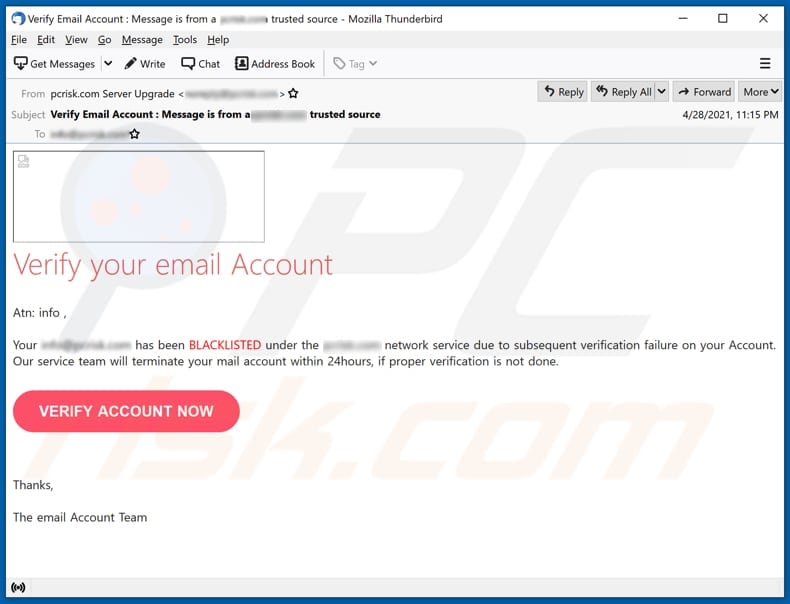
As mentioned in the introduction paragraph, this phishing email is disguised as a letter from the email service provider team. It claims that the email account has been blacklisted due to subsequent verification failure.
Scammers behind this email attempt to trick recipients into believing that they need to verify their email account within 24 hours. Otherwise their account will be terminated.
The "VERIFY ACCOUNT NOW" button in the email opens a phishing website designed to look like a sign-in page. This website asks to enter the email address and a password.
It is used by scammers to steal email account login credentials. Usually, cybercriminals behind phishing emails like this one use stolen accounts to deliver malware, send spam, trick other users into transferring them money, or for other malicious purposes.
Also, they check messages for personal information that could be monetized using one or another method. Therefore, it is strongly recommended not to log into websites without being completely sure that they are official and can be trusted.
It is important to mention that cybercriminals can try to use stolen login credentials to access other accounts (e.g., social media, banking account) as well. Therefore, victims who use the same credentials for multiple accounts are likely to lose access to more than one account.
| Name | Verify Your Email Account Scam |
| Threat Type | Phishing, Scam, Social Engineering, Fraud |
| Fake Claim | Email account is blacklisted |
| Disguise | Notification from the email service provider |
| Symptoms | Unauthorized online purchases, changed online account passwords, identity theft, illegal access of the computer. |
| Distribution methods | Deceptive emails, rogue online pop-up ads, search engine poisoning techniques, misspelled domains. |
| Damage | Loss of sensitive private information, monetary loss, identity theft. |
| Malware Removal (Windows) |
To eliminate possible malware infections, scan your computer with legitimate antivirus software. Our security researchers recommend using Combo Cleaner. Download Combo CleanerTo use full-featured product, you have to purchase a license for Combo Cleaner. 7 days free trial available. Combo Cleaner is owned and operated by RCS LT, the parent company of PCRisk.com. |
A couple of examples of other phishing emails are "Secure Your Email Scam", "Nexi Email Scam", and "Account Service Email Scam". As a rule, they contain a link designed to open a deceptive website where visitors are asked to provide their login credentials or other sensitive information.
In some cases, recipients are asked to provide personal information directly via email. In one way or another, such emails have to be ignored.
It is noteworthy that cybercriminals often use email as a channel to deliver malware. Some examples of emails used to trick users into installing malware on their computers are "SALAMA Email Virus" and "FedEx Express Email Virus".
How do spam campaigns infect computers?
Typically, emails used to trick recipients into installing malware on their computers contain a malicious attachment or a download link for a malicious file. In both cases, recipients infect computers after opening a malicious file that they have downloaded via received email.
Some examples of files that are commonly used to deliver malware via email are Microsoft Office documents, PDF documents, executable files like .exe, archive files (like ZIP, RAR), JavaScript files. It is important to know that documents opened with Microsoft Office 2010 or later do not infect computers unless users enable macros commands (editing or content).
However, older MS Office versions do not have the "Protected View" mode that prevents malicious documents from installing malware without additional permission.
How to avoid installation of malware?
It is strongly advisable to ignore irrelevant emails that are sent from an unknown sender and contain some website link or attachment (or multiple attachments). it is common that cybercriminals use such emails as a channel to deliver their malware.
Usually, emails of this type are disguised as official letters from legitimate entities. Also, it is recommended to avoid opening files that are downloaded through or from third-party downloaders, unofficial pages, Peer-to-Peer networks like torrent clients, eMule, and so on.
Files (and programs) should be downloaded from official websites via direct links. Furthermore, it is important to update and activate installed software using tools and (or) implemented functions that its official developers have created.
It is common that users who use third-party tools unknowingly install malicious software on their computers. Moreover, it is illegal to use 'cracking' tools to activate licensed software.
One more way to avoid malware is to have a reputable anti-spyware or antivirus software and scam the operating system with it on a regular basis. If you've already opened malicious attachments, we recommend running a scan with Combo Cleaner Antivirus for Windows to automatically eliminate infiltrated malware.
Text presented in the Verify Your Email Account email:
Subject: Verify Email Account : Message is from a ******** trusted source
Verify your email Account
Atn: ******** ,Your ******** has been BLACKLISTED under the ******** network service due to subsequent verification failure on your Account.
Our service team will terminate your mail account within 24hours, if proper verification is not done.
VERIFY ACCOUNT NOW
Thanks,The email Account Team
Screenshot of the website used to steal login credentials:
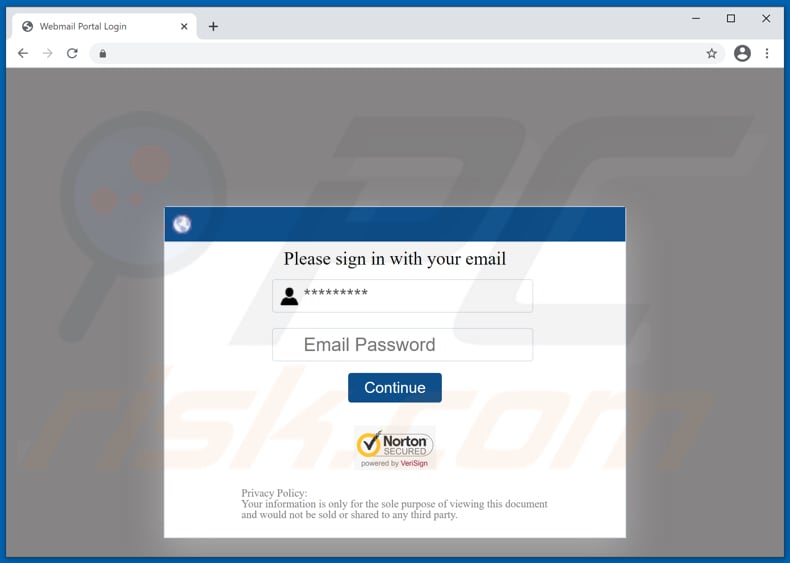
Another variant of email verification-themed spam promoting a phishing website:
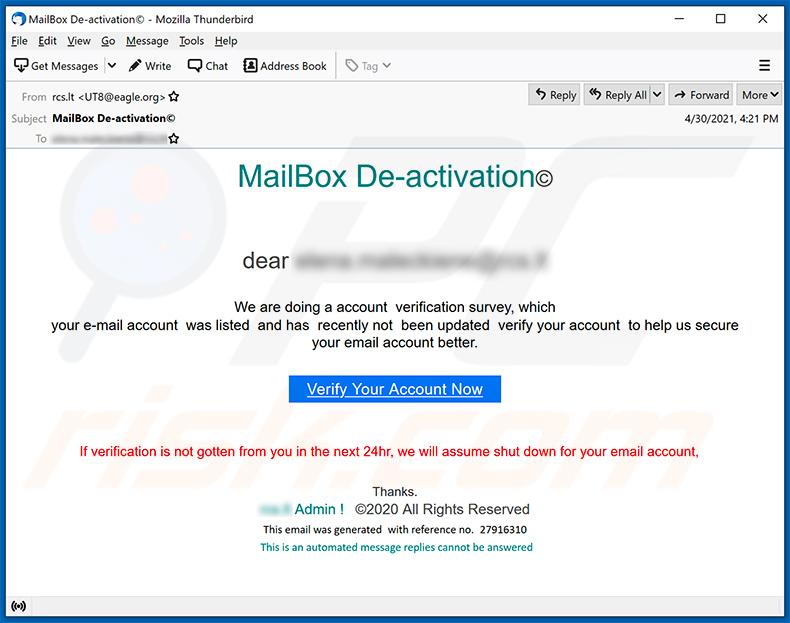
Text presented within:
Subject: MailBox De-activation
MailBox De-activation
dear ********
We are doing a account verification survey, which
your e-mail account was listed and has recently not been updated verify your account to help us secure
your email account better.
Verify Your Account NowIf verification is not gotten from you in the next 24hr, we will assume shut down for your email account,
Thanks.
******** Admin ! 2020 All Rights Reserved
This email was generated with reference no. 27916310
This is an automated message replies cannot be answered
Screenshot of the promoted phishing website:

Yet another email verification-themed spam email promoting a phishing website:

Text presented within:
Subject: ******** WARNING: This Email Account Is Due For Upgrade
Hello ********,
You are receiving this message because your mailbox has not passed the current verification update. Your mailbox ******** needs to be verified. Failure to do that may result in shutdown or inability to receive emails. To continue using your mailbox securely and effectively, you need to upgrade and verify your mailbox.
VERIFY
This service is free.
Webmail © 2021 All rights reserved.
Screenshots of the promoted phishing websites:
Yet another example of verify email account-themed spam promoting a phishing site:

Text presented within:
Subject: Re-verify your email account; -
Hello info
We noticed that you need to re-verify your email account.
Just click the button below (just a few seconds).
For security reasons, we are verifying that the ownership of this email address is valid.Confirm your email address: -
Failure to verify your email address may result in account suspension until verification is complete.
Thank you for being our customer.
- @ - 2021.
Screenshot of the promoted phishing site:

Another example of email verification-themed spam promoting a phishing site:

Text presented within:
Subject: ! ******** verification review {3 pending emails}
********
Unverified email server for ********
User: ********
Your email has suddenly stopped the delivery of [3] important incoming new messages on 03/21/2022 11:36:59 amTo avoid shut down and loss of unsaved data. Please click the button below to validate your service.
VERIFY NOW
Report a Problem Copyright 2022 Mail support. All rights reserved
********
Screenshot of the promoted phishing site:

Yet another variant of "Verify Your Email Account" spam:

Text presented within:
Subject: EMAIL UPDATE
********* (Auto Generated @*********)Dear *********
To continue using your address info, please confirm ownership
approve
or
Refuse
For more details, please log in to the link below.
Login URL: click here*********
* This is a system generated *********. Please do not reply.
Yet another example of "verify your email account" spam email promoting a phishing site:
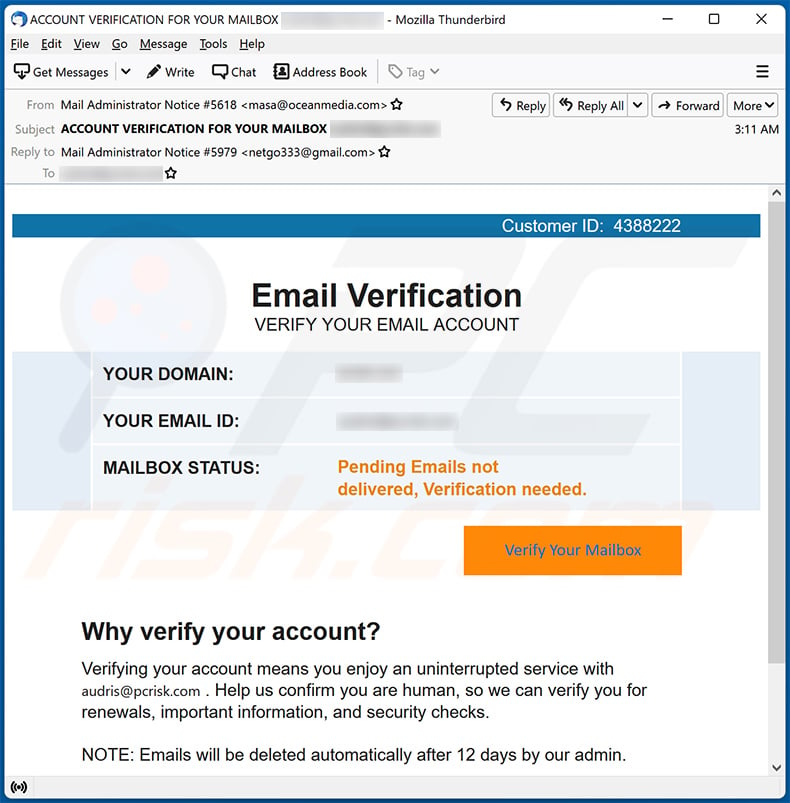
Text presented within:
Subject: ACCOUNT VERIFICATION FOR YOUR MAILBOX ********
Customer ID: 4388222
Email Verification
VERIFY YOUR EMAIL ACCOUNT
YOUR DOMAIN: ********
YOUR EMAIL ID: ********
Mailbox STATUS: Pending Emails not delivered, Verification needed.
Verify Your Mailbox
Why verify your account?
Verifying your account means you enjoy an uninterrupted service with ******** . Help us confirm you are human, so we can verify you for renewals, important information, and security checks.NOTE: Emails will be deleted automatically after 12 days by our admin.
Screenshot of the promoted phishing site designed to imitate the appearance of user's email provider:

Yet another example of email verification-themed spam promoting a phishing site:
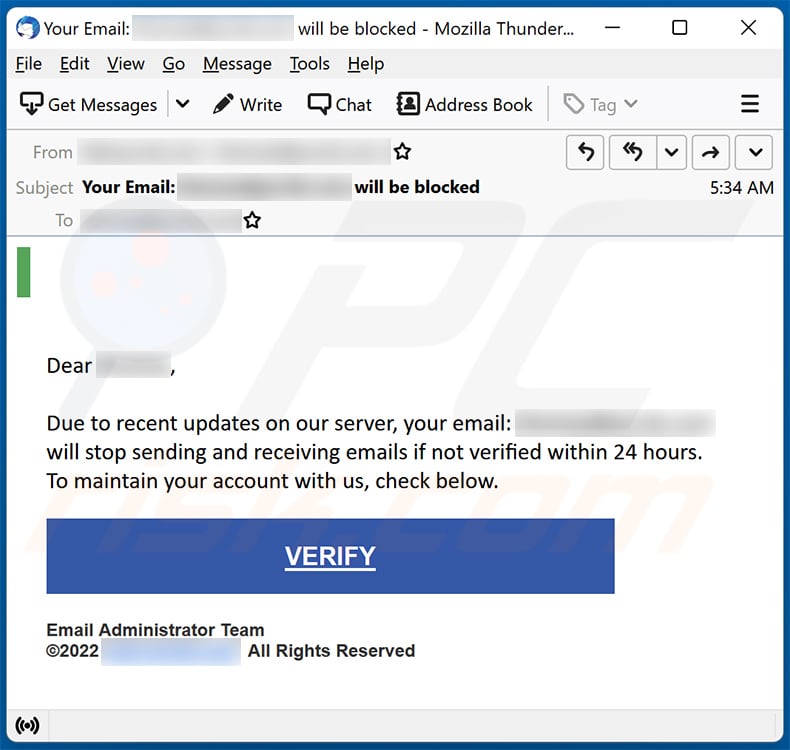
Text presented within:
Subject: Your Email: ******** will be blocked
Dear ********,
Due to recent updates on our server, your email: ******** will stop sending and receiving emails if not verified within 24 hours.
To maintain your account with us, check below.
VERIFY
Email Administrator Team
©2022 ******** All Rights Reserved
Screenshot of the promoted phishing site:

Instant automatic malware removal:
Manual threat removal might be a lengthy and complicated process that requires advanced IT skills. Combo Cleaner is a professional automatic malware removal tool that is recommended to get rid of malware. Download it by clicking the button below:
DOWNLOAD Combo CleanerBy downloading any software listed on this website you agree to our Privacy Policy and Terms of Use. To use full-featured product, you have to purchase a license for Combo Cleaner. 7 days free trial available. Combo Cleaner is owned and operated by RCS LT, the parent company of PCRisk.com.
Quick menu:
- What is Verify Your Email Account spam?
- Types of malicious emails.
- How to spot a malicious email?
- What to do if you fell for an email scam?
Types of malicious emails:
![]() Phishing Emails
Phishing Emails
Most commonly, cybercriminals use deceptive emails to trick Internet users into giving away their sensitive private information, for example, login information for various online services, email accounts, or online banking information.
Such attacks are called phishing. In a phishing attack, cybercriminals usually send an email message with some popular service logo (for example, Microsoft, DHL, Amazon, Netflix), create urgency (wrong shipping address, expired password, etc.), and place a link which they hope their potential victims will click on.
After clicking the link presented in such email message, victims are redirected to a fake website that looks identical or extremely similar to the original one. Victims are then asked to enter their password, credit card details, or some other information that gets stolen by cybercriminals.
![]() Emails with Malicious Attachments
Emails with Malicious Attachments
Another popular attack vector is email spam with malicious attachments that infect users' computers with malware. Malicious attachments usually carry trojans that are capable of stealing passwords, banking information, and other sensitive information.
In such attacks, cybercriminals' main goal is to trick their potential victims into opening an infected email attachment. To achieve this goal, email messages usually talk about recently received invoices, faxes, or voice messages.
If a potential victim falls for the lure and opens the attachment, their computers get infected, and cybercriminals can collect a lot of sensitive information.
While it's a more complicated method to steal personal information (spam filters and antivirus programs usually detect such attempts), if successful, cybercriminals can get a much wider array of data and can collect information for a long period of time.
![]() Sextortion Emails
Sextortion Emails
This is a type of phishing. In this case, users receive an email claiming that a cybercriminal could access the webcam of the potential victim and has a video recording of one's masturbation.
To get rid of the video, victims are asked to pay a ransom (usually using Bitcoin or another cryptocurrency). Nevertheless, all of these claims are false - users who receive such emails should ignore and delete them.
How to spot a malicious email?
While cyber criminals try to make their lure emails look trustworthy, here are some things that you should look for when trying to spot a phishing email:
- Check the sender's ("from") email address: Hover your mouse over the "from" address and check if it's legitimate. For example, if you received an email from Microsoft, be sure to check if the email address is @microsoft.com and not something suspicious like @m1crosoft.com, @microsfot.com, @account-security-noreply.com, etc.
- Check for generic greetings: If the greeting in the email is "Dear user", "Dear @youremail.com", "Dear valued customer", this should raise suspiciousness. Most commonly, companies call you by your name. Lack of this information could signal a phishing attempt.
- Check the links in the email: Hover your mouse over the link presented in the email, if the link that appears seems suspicious, don't click it. For example, if you received an email from Microsoft and the link in the email shows that it will go to firebasestorage.googleapis.com/v0... you shouldn't trust it. It's best not to click any links in the emails but to visit the company website that sent you the email in the first place.
- Don't blindly trust email attachments: Most commonly, legitimate companies will ask you to log in to their website and to view any documents there; if you received an email with an attachment, it's a good idea to scan it with an antivirus application. Infected email attachments are a common attack vector used by cybercriminals.
To minimise the risk of opening phishing and malicious emails we recommend using Combo Cleaner Antivirus for Windows.
Example of a spam email:

What to do if you fell for an email scam?
- If you clicked on a link in a phishing email and entered your password - be sure to change your password as soon as possible. Usually, cybercriminals collect stolen credentials and then sell them to other groups that use them for malicious purposes. If you change your password in a timely manner, there's a chance that criminals won't have enough time to do any damage.
- If you entered your credit card information - contact your bank as soon as possible and explain the situation. There's a good chance that you will need to cancel your compromised credit card and get a new one.
- If you see any signs of identity theft - you should immediately contact the Federal Trade Commission. This institution will collect information about your situation and create a personal recovery plan.
- If you opened a malicious attachment - your computer is probably infected, you should scan it with a reputable antivirus application. For this purpose, we recommend using Combo Cleaner Antivirus for Windows.
- Help other Internet users - report phishing emails to Anti-Phishing Working Group, FBI’s Internet Crime Complaint Center, National Fraud Information Center and U.S. Department of Justice.
Share:

Tomas Meskauskas
Expert security researcher, professional malware analyst
I am passionate about computer security and technology. I have an experience of over 10 years working in various companies related to computer technical issue solving and Internet security. I have been working as an author and editor for pcrisk.com since 2010. Follow me on Twitter and LinkedIn to stay informed about the latest online security threats.
PCrisk security portal is brought by a company RCS LT.
Joined forces of security researchers help educate computer users about the latest online security threats. More information about the company RCS LT.
Our malware removal guides are free. However, if you want to support us you can send us a donation.
DonatePCrisk security portal is brought by a company RCS LT.
Joined forces of security researchers help educate computer users about the latest online security threats. More information about the company RCS LT.
Our malware removal guides are free. However, if you want to support us you can send us a donation.
Donate


▼ Show Discussion